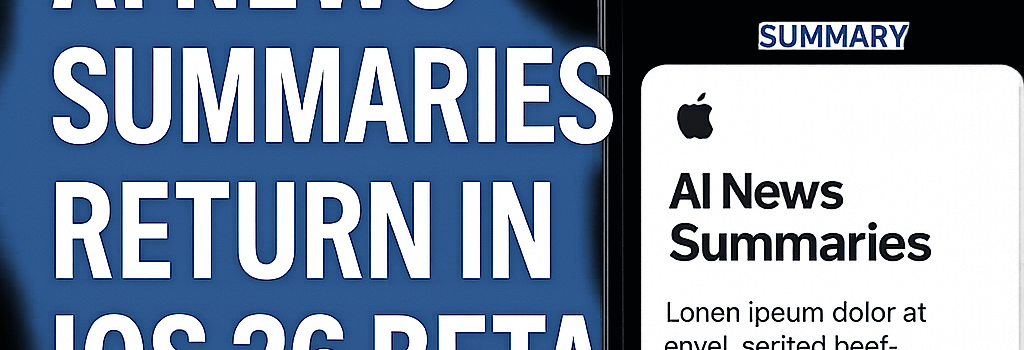Apple’s AI News Summaries Return in iOS 26 Beta

After a temporary removal in January, Apple’s AI-powered news notification summaries are back in the latest developer betas of iOS 26, iPadOS 26 and macOS 26. The revived feature ships with a bold red disclaimer and fresh under-the-hood improvements aimed at reducing misinterpretations.
Background: Why Summaries Were Disabled
Earlier this year, Apple temporarily disabled its Apple Intelligence news summaries following several high-profile errors. One errant notification incorrectly stated that Luigi Mangione, the alleged murderer of UnitedHealthcare CEO Brian Thompson, had died by suicide. The factual inaccuracy sparked complaints from publishers and prompted Apple to pull the feature in the iOS 18.3 update.
What’s New in iOS 26 Beta 4
- Red Disclaimer Banner: A persistent red banner warns, “Summarization may change the meaning of the original headlines.”
- “Summarized by Apple Intelligence” Tag: Each AI summary carries a distinct caption and an italicized font style to differentiate it from raw notifications.
- Enable/Disable Controls: During setup, users choose whether to receive summaries from three categories: News & Entertainment, Communication & Social, and Others.
- Under-the-Hood AI Enhancements: Apple hints at architectural upgrades—likely model quantization, on-device transformer inference optimizations and reduced memory footprint—to improve summary accuracy and latency.
Technical Deep Dive: How Summaries Are Generated
Apple Intelligence leverages a custom transformer-based summarization model, optimized for on-device execution. Key technical points include:
- Model Quantization: Converting 32-bit floating-point weights to 8-bit integers, cutting memory usage by up to 75% without significant accuracy loss.
- Privacy-First Inference: All processing occurs locally. No raw news text or user interaction data is sent to Apple servers, aligning with Apple’s differential privacy and data minimization policies.
- Latency Improvements: Pipeline restructuring reduces end-to-end inference time by ~30%, from an average of 400 ms to 280 ms on A16 and M2 chips.
Expert Opinions
“On-device summarization poses unique constraints compared to cloud-based NLP services,” says Dr. Nina Rao, Senior Research Scientist at Stanford AI Lab. “Balancing model size, speed, and accuracy is critical, and Apple’s latest betas show promising optimizations.”
“The prominent disclaimer is a smart UX move,” notes Jordan Evans, VP of Product at NewsTech Analytics. “It sets realistic expectations and preserves trust between publishers and readers.”
Comparisons to Other Platforms
Unlike Android’s reliance on cloud-hosted AI for headlines (e.g., Google’s Generative AI summaries in Google News), Apple’s fully offline approach enhances privacy but demands careful resource management. Recent tests show Apple’s summaries consume ~25 MB of storage for models and temporary data versus ~50 MB for comparable cloud-enabled systems.
Future Outlook and Release Timeline
With public betas slated for late July, Apple is on track to ship these updates to consumers in September or October 2025. Potential future enhancements include:
- Adaptive summarization length based on user reading habits.
- Inclusion of sentiment tags (e.g., neutral, positive, negative).
- Expanded language support beyond the initial English rollout.
Implications for Developers and Publishers
News app developers should:
- Implement the Apple Intelligence SDK callbacks to preview and flag potential mis-summaries.
- Design notification interfaces that clearly distinguish AI summaries from original headlines.
- Monitor analytics for summary-click-through rates to assess user trust and engagement.
Publishers, meanwhile, can leverage the new disclaimers to educate audiences on AI limitations and maintain editorial integrity.
Conclusion: Apple’s return of news notification summaries—tempered by a red warning label and bolstered by technical refinements—marks a cautious but crucial step forward for on-device AI. As the feature exits beta later this year, accuracy and user control will remain pivotal to its success.